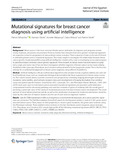| dc.description.abstract | Background
Breast cancer is the most common female cancer worldwide. Its diagnosis and prognosis remain scanty, imprecise, and poorly documented. Previous studies have indicated that some genetic mutational signatures are suspected to lead to progression of various breast cancer scenarios. There is paucity of data on the role of AI tools in delineating breast cancer mutational signatures. This study sought to investigate the relationship between breast cancer genetic mutational profiles using artificial intelligence models with a view to developing an accurate prognostic prediction based on breast cancer genetic signatures. Prior research on breast cancer has been based on symptoms, origin, and tumor size. It has not been investigated whether diagnosis of breast cancer can be made utilizing AI platforms like Cytoscape, Phenolyzer, and Geneshot with potential for better prognostic power. This is the first ever attempt for a combinatorial approach to breast cancer diagnosis using different AI platforms.
Method
Artificial intelligence (AI) are mathematical algorithms that simulate human cognitive abilities and solve difficult healthcare issues such as complicated biological abnormalities like those experienced in breast cancer scenarios. The current models aimed to predict outcomes and prognosis by correlating imaging phenotypes with genetic mutations, tumor profiles, and hormone receptor status and development of imaging biomarkers that combine tumor and patient-specific features. Geneshotsav 2021, Cytoscape 3.9.1, and Phenolyzer Nature Methods, 12:841–843 (2015) tools, were used to mine breast cancer-associated mutational signatures and provided useful alternative computational tools for discerning pathways and enriched networks of genes of similarity with the overall goal of providing a systematic view of the variety of mutational processes that lead to breast cancer development. The development of novel-tailored pharmaceuticals, as well as the distribution of prospective treatment alternatives, would be aided by the collection of massive datasets and the use of such tools as diagnostic markers.
Results
Specific DNA-maintenance defects, endogenous or environmental exposures, and cancer genomic signatures are connected. The PubMed database (Geneshot) search for the keywords yielded a total of 21,921 genes associated with breast cancer. Then, based on their propensity to result in gene mutations, the genes were screened using the Phenolyzer software. These platforms lend credence to the fact that breast cancer diagnosis using Cytoscape 3.9.1, Phenolyzer, and Geneshot 2021 reveals high profile of the following mutational signatures: BRCA1, BRCA2, TP53, CHEK2, PTEN, CDH1, BRIP1, RAD51C, CASP3, CREBBP, and SMAD3. | en_US |

